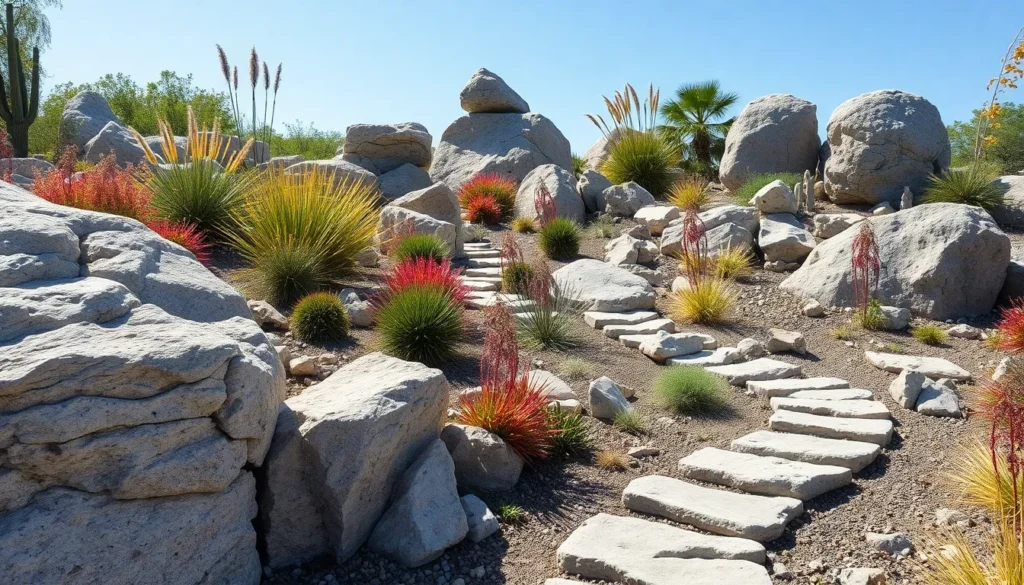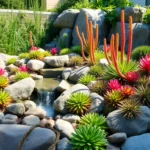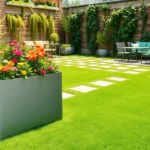We’ve all walked past those stunning rock gardens that seem to effortlessly blend natural beauty with artistic design. These low-maintenance landscapes offer the perfect solution for challenging spaces where traditional gardens struggle to thrive. Whether you’re dealing with steep slopes sandy soil or simply want to create a unique focal point rock gardens deliver both visual impact and practical benefits.
The beauty of rock gardening lies in its versatility. We can transform everything from small corner spaces to expansive hillsides into captivating displays that require minimal water and upkeep. With the right combination of stones plants and design elements you’ll create a industry that looks stunning year-round while supporting local wildlife and reducing your gardening workload.
Ready to discover how simple rocks and carefully chosen plants can transform your outdoor space into a natural masterpiece? Let’s explore the creative possibilities that’ll make your neighbors stop and admire your industry expertise.
Choose the Perfect Location for Your Rock Garden
Selecting the right spot for your rock garden determines its long term success and visual impact. We’ll help you identify the ideal location by evaluating key environmental factors and practical considerations.
Consider Sunlight and Drainage Requirements
Sunlight exposure directly affects which plants you can successfully grow in your rock garden. Most alpine and succulent plants that thrive in rock gardens need at least 6 hours of direct sunlight daily. We recommend observing your potential site throughout different times of day to track sun patterns before making your final decision.
Drainage becomes the foundation of rock garden success since waterlogged soil kills most rock garden plants. Test your drainage by digging a hole 12 inches deep and filling it with water. If water remains after 24 hours you’ll need to improve drainage with gravel or sand amendments. Sloped areas naturally provide better drainage than flat terrain.
Morning sun with afternoon shade works perfectly for many rock garden varieties. This combination prevents excessive heat stress while providing sufficient light for healthy growth. Eastern facing slopes or locations near structures that create afternoon shade offer these ideal conditions.
Evaluate Slope and Natural Terrain Features
Slopes between 10 to 30 degrees create the most visually appealing and functional rock gardens. These gradients allow proper water runoff while showcasing rocks and plants at attractive viewing angles. Steeper slopes require terracing or retaining structures to prevent erosion.
Natural rock outcroppings provide excellent starting points for expanding your rock garden design. Work with existing stone formations instead of fighting against them to create more authentic looking displays. These features often indicate good drainage and stable soil conditions.
Uneven terrain adds character and creates natural planting pockets for different plant zones. Depressions collect moisture for plants that need slightly more water while elevated areas stay drier for drought tolerant species. We suggest mapping these microclimates before selecting plant varieties.
Plan for Easy Access and Maintenance
Pathway planning ensures you can reach all areas of your rock garden for weeding and plant care. Create stepping stone paths or narrow walkways that blend naturally with your design. Position these access routes before installing heavy rocks to avoid disrupting completed sections.
Tool storage proximity reduces maintenance effort and keeps your rock garden looking its best. Locate your garden within 50 feet of water sources and tool storage areas. This convenience encourages regular care and makes seasonal tasks more manageable.
Viewing angles from windows and outdoor living spaces maximize your enjoyment of the garden year round. Position your rock garden where you’ll see it frequently from indoor spaces during winter months. Consider multiple viewing perspectives to ensure the design looks attractive from various angles around your property.
Select the Right Types of Rocks and Stones
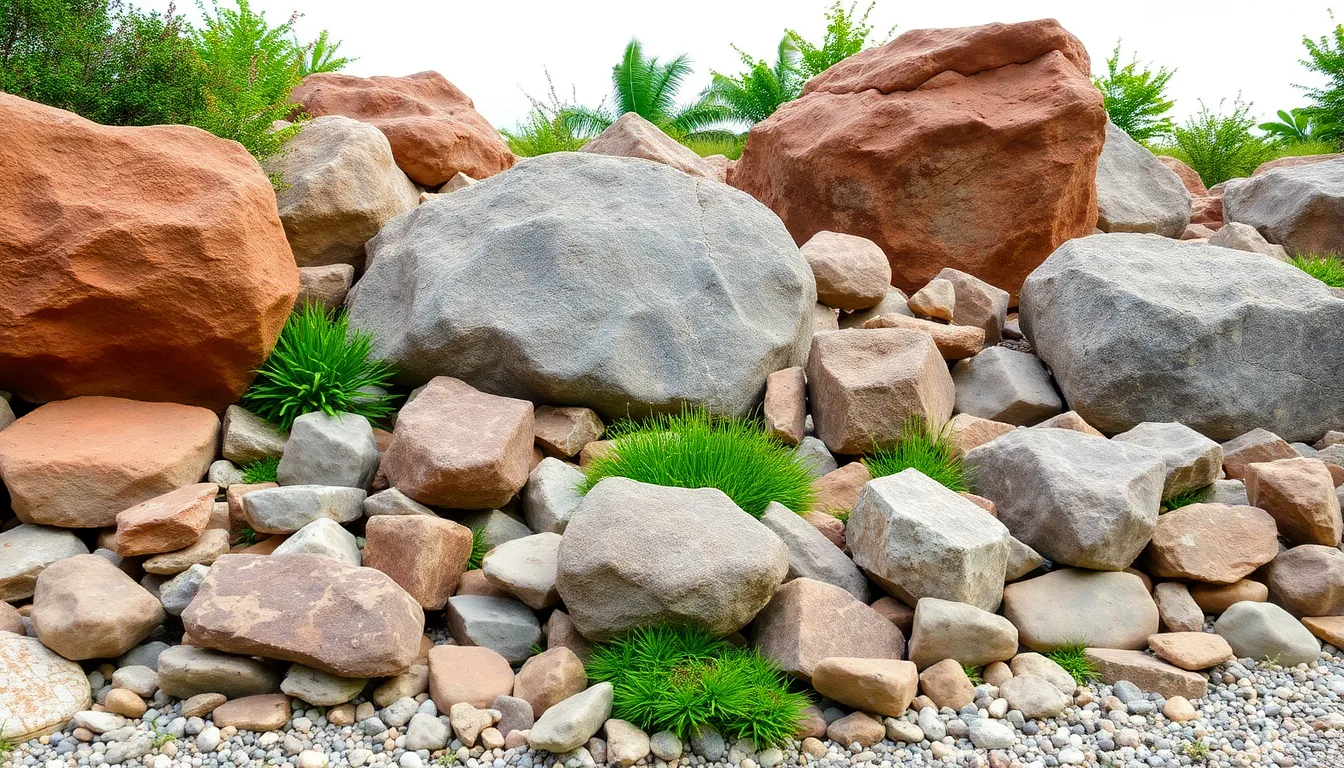
Choosing the right stones forms the foundation of our rock garden’s visual impact and long-term success. We’ll explore three essential strategies that transform ordinary stone selections into stunning garden features.
Incorporate Local Native Stone Materials
Native stones create authentic connections between our garden and the surrounding industry. We recommend sourcing materials like sandstone, limestone, or granite from regional quarries to achieve natural harmony while reducing transportation costs and environmental impact.
Local materials weather consistently with existing industry features and blend seamlessly with regional architecture. We find that native stones often cost less than imported alternatives since they don’t require long-distance shipping.
Regional stone suppliers typically offer better knowledge about how exact materials perform in local climate conditions. We suggest visiting nearby quarries or stone yards to examine texture, durability, and color variations before making final selections.
Mix Different Textures and Sizes
Texture variety creates visual depth that keeps viewers engaged throughout our rock garden space. We combine smooth river rocks with rough, angular quarried stones to establish contrast and prevent monotonous appearances.
Size variation guides the eye naturally through different garden zones using large boulders as focal points and smaller stones as transitional elements. We typically use boulders weighing 100 to 500 pounds for primary anchors, medium rocks between 20 to 50 pounds for secondary features, and small stones under 10 pounds for pathway details.
Irregular shapes add organic appeal that mimics natural stone formations found in mountain environments. We position jagged, weathered stones alongside rounded specimens to create authentic wilderness aesthetics.
Consider Color Coordination and Visual Balance
Color harmony prevents our rock garden from appearing chaotic while maintaining visual interest across seasons. We select stone palettes that complement our home’s exterior and existing industry elements rather than competing with them.
Neutral tones like gray, beige, and earth browns provide versatile foundations that support various plant colors throughout growing seasons. We avoid using more than three primary stone colors to maintain sophisticated restraint.
Visual weight distribution ensures no single area overwhelms the overall composition. We place darker, heavier-appearing stones lower in arrangements and lighter-colored specimens at higher elevations to create stable, pleasing proportions that feel naturally balanced.
Plan Your Rock Garden Layout and Design
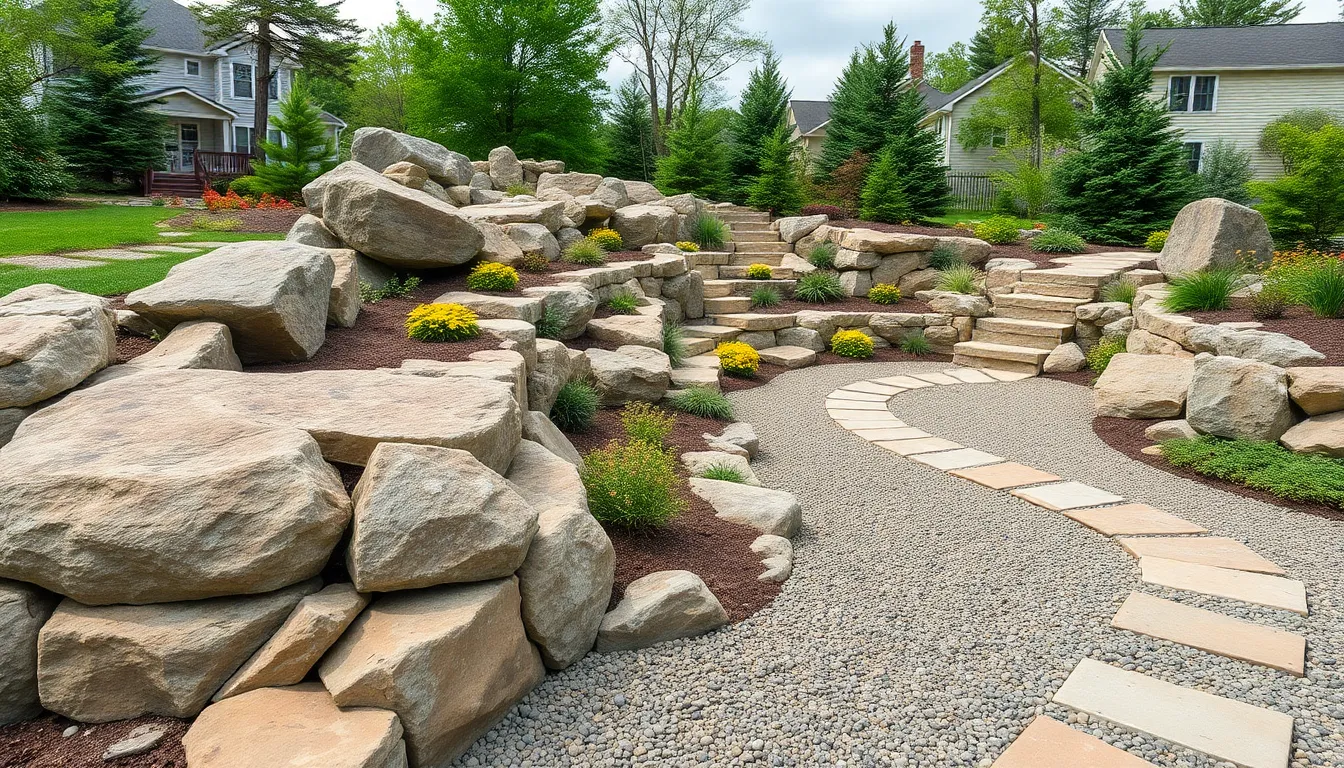
Now that we’ve covered location selection and stone choices, it’s time to focus on creating a cohesive design that brings our rock garden vision to life. Strategic planning ensures our garden flows naturally and provides maximum visual impact throughout the seasons.
Create Natural-Looking Rock Formations
Random groupings form the foundation of authentic rock garden design rather than neat rows that appear artificial. We recommend arranging stones in clusters of three to five pieces, varying their sizes to mimic how rocks naturally settle in mountain landscapes. Burying one-third of each rock creates stability while suggesting they’ve been in place for centuries.
Local materials enhance the natural appearance by connecting our garden to the surrounding environment. Native stones blend seamlessly with existing industry features and often cost less than imported alternatives. We suggest collecting weathered fieldstone, limestone, or granite from local suppliers who source materials within a 50-mile radius of our location.
Layering techniques add depth and dimension to our rock formations. Placing larger boulders as anchor points first, then filling gaps with medium-sized stones and finishing with smaller accent pieces creates visual hierarchy. Tilting rocks at slight angles mimics natural geological processes while providing better drainage for plants nestled between them.
Design Pathways and Viewing Areas
Stepping stones help movement through our rock garden while protecting delicate plants from foot traffic. We recommend spacing flat stones 18 to 24 inches apart for comfortable walking, choosing pieces that measure at least 12 inches across for stability. Natural flagstone or flat fieldstone works exceptionally well for these pathways.
Seating areas transform our rock garden into an outdoor retreat where we can relax and observe the intricate details. Built-in stone benches using large flat rocks supported by smaller boulders provide durable seating that weathers beautifully. We suggest positioning these areas to capture morning sun or afternoon shade depending on our climate preferences.
Winding paths create mystery and encourage exploration throughout the garden space. Curved walkways reveal new vistas around each bend and make small gardens appear larger than their actual dimensions. We recommend using crushed gravel or decomposed granite between stepping stones to define the path while allowing for proper drainage.
Establish Focal Points and Visual Interest
Boulders serve as natural anchors that define spaces and create dramatic focal points within our rock garden design. We suggest using specimens weighing 500 to 1,000 pounds as primary features, positioning them at the garden’s highest points or where pathways converge. These substantial stones provide scale reference and visual weight that grounds the entire composition.
Sculptures merge art with nature when we select pieces that complement rather than compete with our stone materials. Abstract forms carved from the same rock type as our garden stones create cohesive artistic statements. We recommend choosing sculptures that weather naturally and won’t require ongoing maintenance to preserve their appearance.
Varied elevations add three-dimensional interest that prevents our rock garden from appearing flat or monotonous. Building terraced levels using retaining walls of stacked stone creates planting pockets at different heights. We suggest incorporating elevation changes of 12 to 36 inches between levels to maximize visual impact while maintaining accessibility for maintenance tasks.
Choose Drought-Tolerant Plants for Rock Gardens
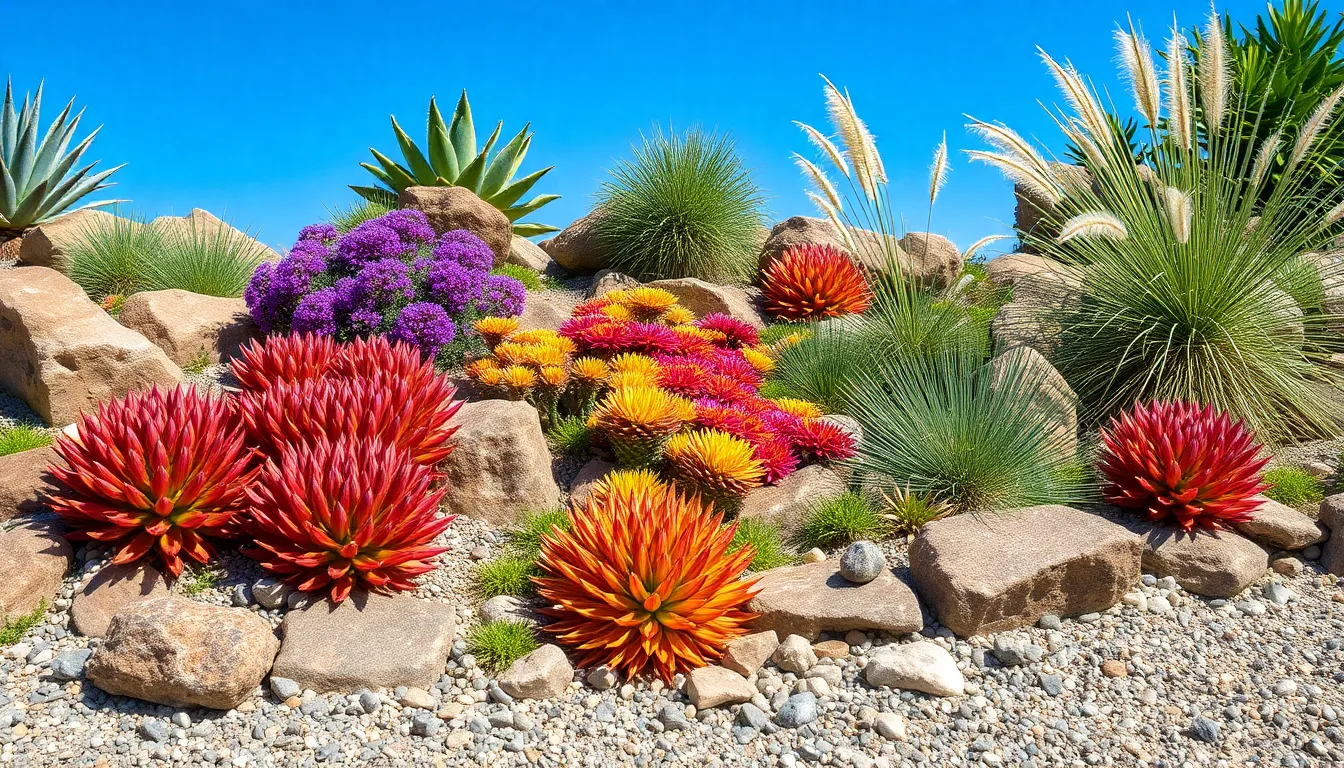
Selecting the right plants transforms your rock garden from a simple stone arrangement into a thriving network. Drought-tolerant varieties naturally complement rocky environments while requiring minimal water and maintenance.
Select Alpine and Succulent Varieties
Alpine plants excel in rock garden conditions because they’ve evolved to survive harsh mountain environments with excellent drainage and limited water. We recommend starting with classic choices like Sempervivum (Hens and Chicks), which forms colorful rosettes and spreads naturally across rock crevices. Sedums offer incredible variety, from the tiny Sedum acre with its bright yellow flowers to larger varieties like Autumn Joy that provide late-season color.
Succulent options extend beyond traditional alpine plants to include hardy varieties that withstand temperature fluctuations. Yucca plants create dramatic architectural elements while requiring virtually no supplemental watering once established. Ice plants (Delosperma) produce vibrant daisy-like flowers in purple, yellow, or orange while tolerating both drought and cold temperatures down to -10°F.
These varieties thrive in well-draining soil and actually prefer the lean conditions that rock gardens provide naturally. Overwatering kills more alpine and succulent plants than drought, making them perfect companions for stone landscapes.
Incorporate Ornamental Grasses and Groundcovers
Ornamental grasses add movement and texture that softens the hard edges of stone while requiring minimal care. Blue Oat Grass (Helictotrichon sempervirens) creates stunning blue-gray tufts that contrast beautifully with warm-toned rocks. Fountain Grass provides graceful arching foliage and feathery plumes that catch sunlight and create visual interest throughout multiple seasons.
Groundcovers fill gaps between rocks while preventing weeds and erosion. Creeping Thyme releases fragrant oils when stepped on and produces tiny purple or white flowers that attract beneficial pollinators. Woolly Thyme offers a silver-gray carpet that withstands foot traffic while requiring no supplemental watering after establishment.
Wild Ginger works well in partially shaded rock gardens, spreading slowly to create dense mats of heart-shaped leaves. Creeping Phlox explodes with color in spring, covering rocks with pink, purple, or white blooms before settling into an attractive green groundcover for the remainder of the growing season.
Add Seasonal Color with Hardy Perennials
Hardy perennials provide changing displays throughout the growing season while returning year after year with minimal intervention. Black-eyed Susans (Rudbeckia) bloom from midsummer through fall, creating bright yellow flowers that stand up to heat and drought conditions. Coneflowers (Echinacea) offer purple, pink, or white daisy-like blooms that attract butterflies while tolerating poor soil and dry spells.
Daylilies adapt to various conditions and bloom in waves throughout summer, with individual flowers lasting just one day but plants producing dozens of buds per stalk. Catmint creates fragrant blue-purple flower spikes that bloom repeatedly when cut back, while its gray-green foliage provides consistent color even when not flowering.
Russian Sage contributes airy texture with its fine silver foliage and small blue flowers that appear in late summer. Blanket Flower (Gaillardia) produces bright red and yellow blooms continuously from spring until frost, requiring no deadheading and actually preferring poor, sandy soil conditions that many rock gardens provide.
Build Proper Drainage and Foundation Systems
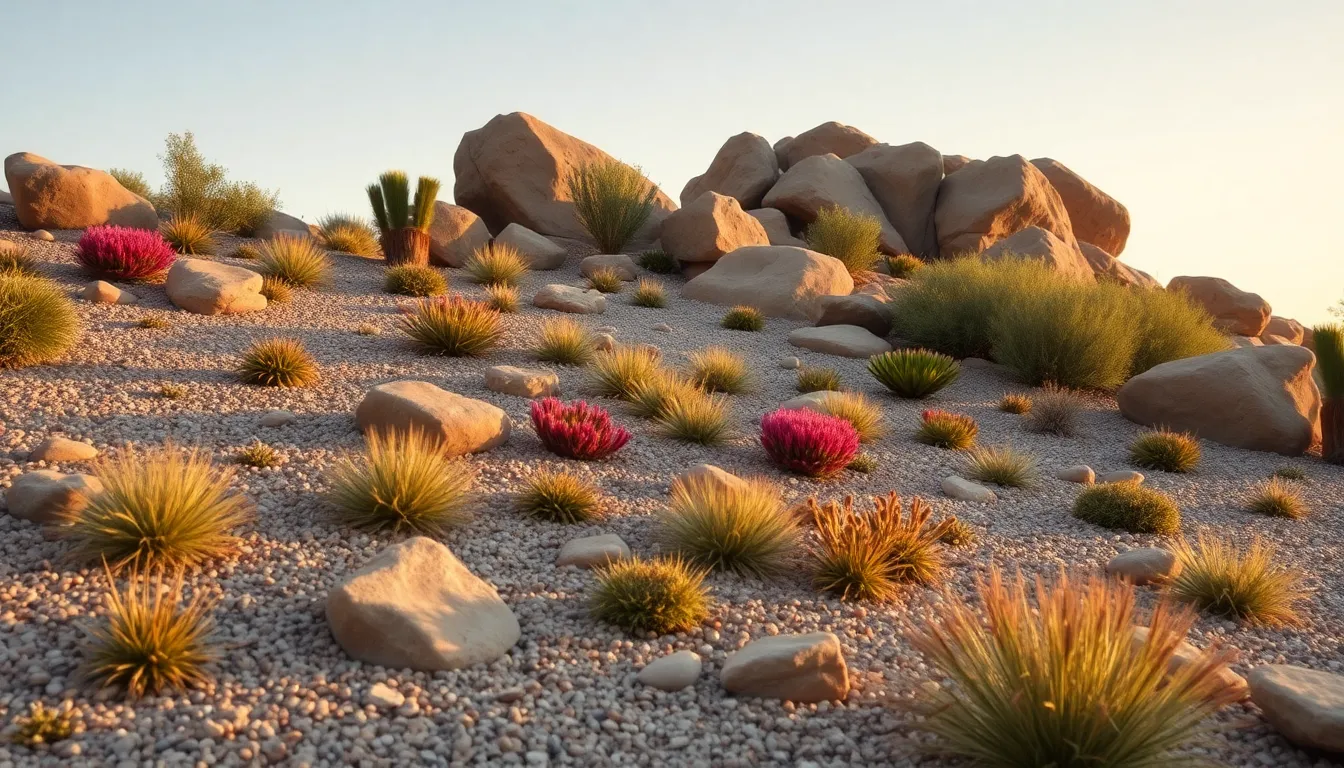
Effective drainage and foundation systems form the backbone of any successful rock garden. We’ll establish these critical elements before adding rocks and plants to ensure long-term garden health.
Install Gravel Base Layers
Gravel base layers enhance drainage and prevent waterlogging, which can kill even the most drought-tolerant plants. We recommend excavating the designated area to a depth of 12-18 inches, then filling the bottom 6-8 inches with coarse gravel or crushed stone. This foundation layer creates a reservoir that allows excess water to drain away from plant roots while maintaining proper soil structure.
Layering different gravel sizes optimizes drainage performance throughout your rock garden. We start with larger stones (2-3 inches) at the bottom, followed by medium gravel (1-2 inches), and finish with fine gravel or coarse sand as the top layer. Each layer should be approximately 2-3 inches thick to create effective filtration without compromising stability.
Create Drainage Channels and Slopes
Drainage channels and slopes guide water away from plants and prevent erosion by directing runoff to designated areas. We design our rock gardens with gentle slopes ranging from 10-30 degrees, which allows water to flow naturally without creating excessive erosion or standing water pools. Strategic placement of larger rocks creates natural channels that funnel water toward collection points or existing drainage systems.
Installing French drains or swales enhances water management in areas prone to heavy rainfall. We position these drainage features along the garden’s perimeter and at key collection points where water naturally accumulates. Perforated pipes wrapped in industry fabric and surrounded by gravel create effective underground drainage systems that remain invisible while protecting your plants.
Prevent Soil Erosion and Water Damage
Terracing and level differences control soil movement and retain moisture while creating visually appealing elevation changes throughout your rock garden. We construct retaining walls using larger stones or boulders to create stable planting pockets that prevent soil washout during heavy rains. These terraced areas also provide better root zones for plants while adding architectural interest to the overall design.
Implementing ground stabilization techniques protects your investment from weather-related damage. We use erosion control fabric beneath soil layers in steep areas and strategically place rocks to break up water flow patterns. Proper plant selection also contributes to erosion control, as deep-rooted varieties like ornamental grasses help bind soil particles together while adding natural beauty to your rock garden industry.
Add Water Features to Your Rock Garden
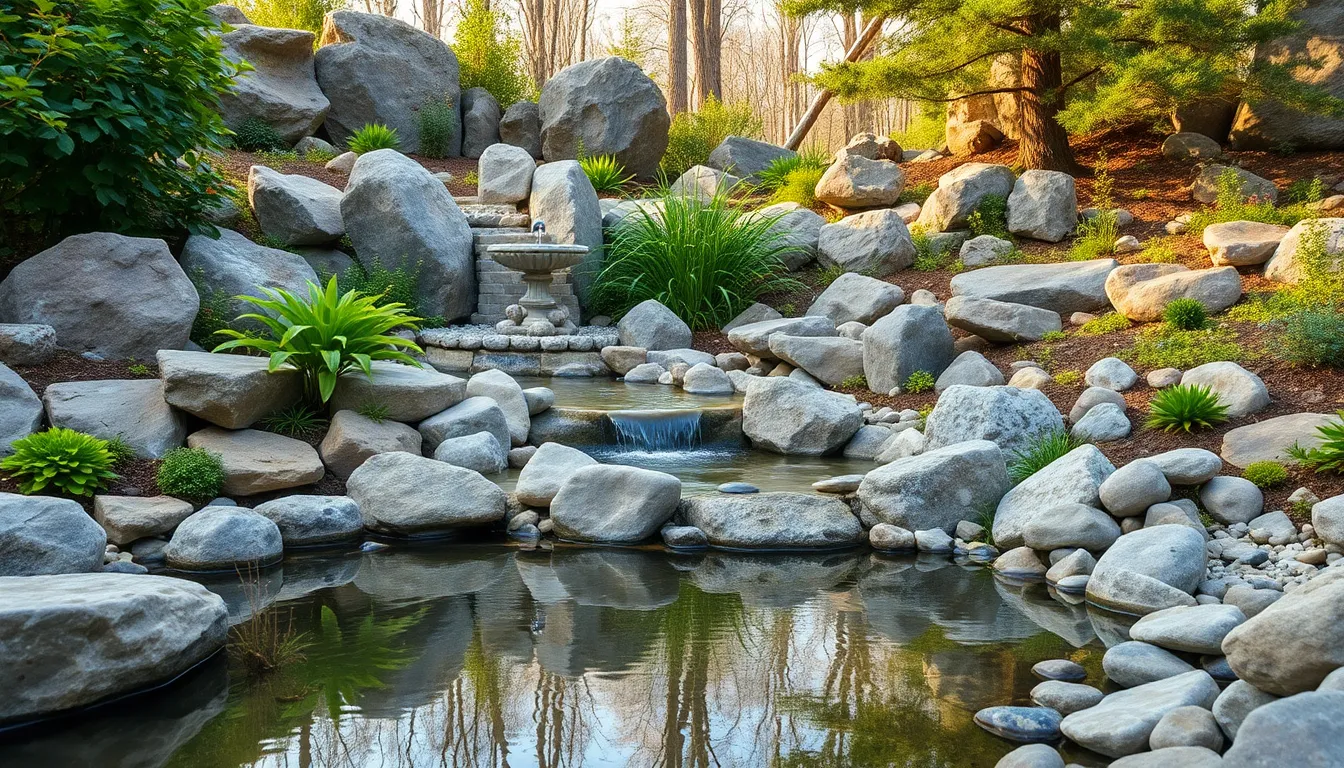
Water elements transform rock gardens into ever-changing outdoor sanctuaries that engage multiple senses. The gentle sounds and visual movement of water create peaceful atmospheres while supporting local wildlife biodiversity.
Install Small Fountains or Waterfalls
Small fountains bring an air of peace and tranquility to rock garden spaces. We recommend positioning fountains near seating areas where you’ll spend time relaxing and enjoying the calming water sounds. Solar powered options eliminate electrical concerns while providing sustainable operation throughout daylight hours.
Waterfalls create dramatic focal points when integrated with existing rock formations. Natural stone cascades work best when water flows over multiple levels of carefully positioned boulders. Recirculating pumps keep water moving efficiently while minimizing maintenance requirements.
Installation requires proper electrical planning for traditional fountain systems. Underground cables should connect to GFCI protected outlets for safety compliance. Pre formed fountain basins simplify installation while ensuring proper water containment and circulation.
Create Natural-Looking Streams
Natural looking streams mimic mountain waterways by following irregular pathways through rock gardens. We suggest designing gentle curves that wind between planted areas and stone groupings. Variable widths create authentic appearances that change throughout the stream’s length.
Rock lined channels guide water flow while preventing erosion around plant roots. Flat stones create shallow pools that reflect sky and surrounding vegetation. Rounded river rocks add texture variation and help oxygenate flowing water naturally.
Submersible pumps circulate water from collection basins back to stream sources. Hidden tubing runs beneath rocks and soil to maintain the illusion of natural springs. Flow rates should match your garden’s scale to avoid overwhelming smaller planted areas.
Design Reflecting Pools and Bird Baths
Reflecting pools create visual appeal through mirror like water surfaces that double garden views. Still water reflects clouds, trees, and surrounding rock formations to expand perceived garden space. We position pools where morning light enhances reflective qualities throughout the day.
Bird baths attract wildlife while adding movement and activity to rock garden environments. Shallow basins with textured bottoms provide secure footing for visiting birds. Multiple depth levels accommodate different bird species from small finches to larger songbirds.
Strategic placement near protective shrubs gives birds safe retreat options while bathing. Fresh water sources support local ecosystems and create opportunities for wildlife observation. Regular cleaning maintains water quality and prevents algae buildup that deters bird visits.
Incorporate Decorative Elements and Accessories
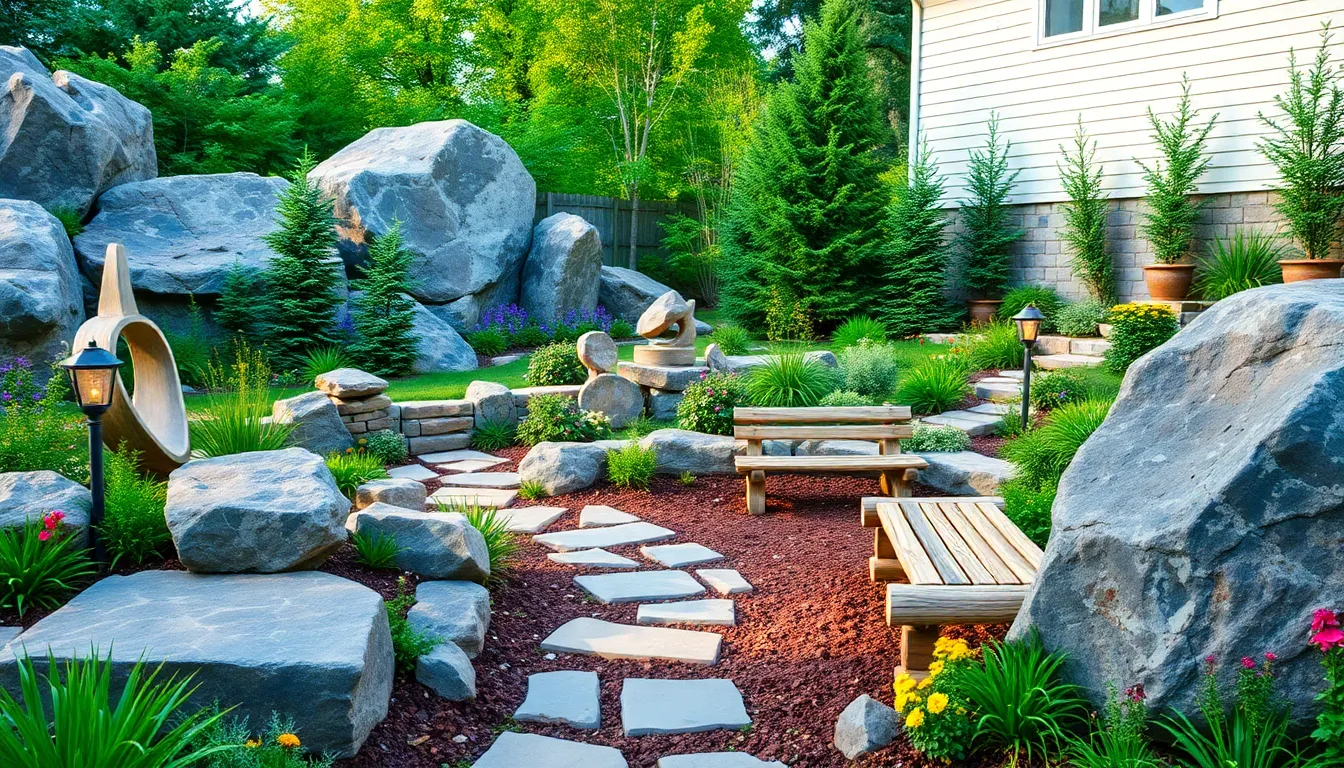
We can transform our rock garden from a simple plant display into a captivating outdoor masterpiece by thoughtfully integrating decorative elements that complement the natural stone industry. Strategic placement of accessories enhances visual interest while maintaining the garden’s authentic character.
Add Garden Sculptures and Art Pieces
Abstract stone sculptures merge seamlessly with our rock garden’s natural aesthetic while creating compelling focal points that draw the eye. Choosing pieces crafted from materials that echo our existing stones ensures visual harmony throughout the space.
Natural elements like weathered driftwood or sculptural branches add organic textures that soften the hard edges of our rock formations. Positioning these pieces among our plantings creates interesting contrasts between smooth and rough surfaces.
Large boulders serve as natural sculptural elements when we position them strategically as standalone features or stack them for dramatic vertical interest. Creating these stone arrangements mimics natural rock formations found in mountain landscapes.
Install Strategic Lighting Features
Path lighting using solar powered fixtures illuminates our walkways safely while highlighting our carefully selected plants during evening hours. Installing these lights along stepping stone pathways creates an inviting glow that extends our garden’s usability into nighttime.
Accent lighting strategically placed beneath our water features or sculptures transforms our rock garden into an enchanting nighttime display. Focusing warm LED lights upward through our plantings creates dramatic shadows and emphasizes textural contrasts.
Spotlights directed at our most impressive boulders or architectural plants establish nighttime focal points that mirror our daytime design priorities. Using timers ensures our lighting system operates efficiently without constant manual adjustment.
Include Seating Areas and Viewing Spots
Stepping stones and pathways create inviting routes that naturally lead visitors to comfortable viewing areas where they can appreciate our garden’s details. Designing these walkways with varying stone sizes adds visual rhythm while providing stable footing.
Log or stone benches constructed from materials that match our rock selection offer rustic seating options that blend naturally with the industry. Positioning these benches to face our most dramatic views maximizes the contemplative experience.
Natural seating carved from large rocks or boulders provides impromptu resting spots that feel completely integrated with our garden’s design. Selecting stones with naturally flat surfaces eliminates the need for additional modifications while maintaining authenticity.
Maintain Your Rock Garden Throughout the Seasons
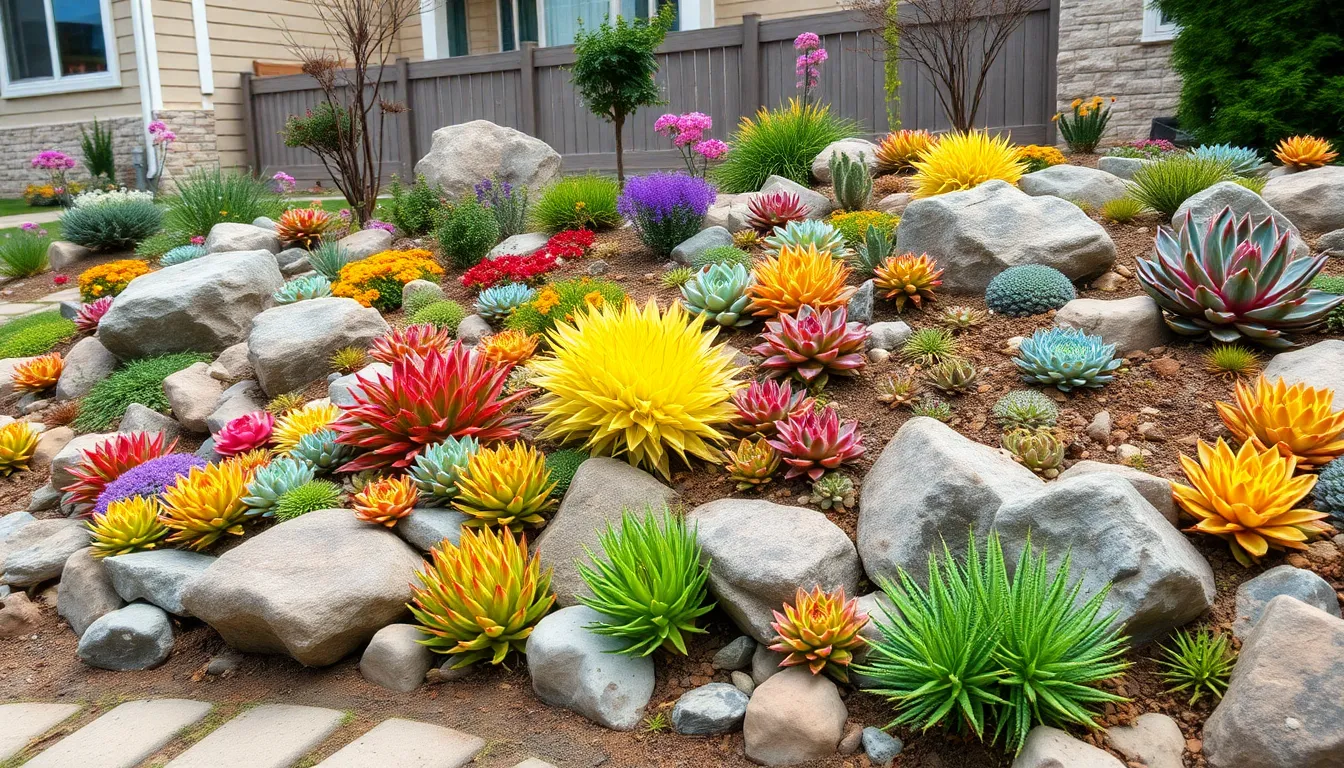
Seasonal maintenance keeps our rock garden healthy and visually stunning year-round. We’ll explore essential care tasks that preserve both plants and hardscape elements through changing weather conditions.
Perform Regular Weeding and Plant Care
Regular weeding prevents unwanted plants from competing with our carefully selected rock garden specimens for water and nutrients. We should inspect the garden weekly during growing season to catch weeds while they’re small and easier to remove. Hand pulling works best for most weeds since it avoids disturbing nearby plants or displacing stones.
Adequate watering becomes crucial during hot spells when even drought-tolerant plants need extra moisture. We recommend installing drip irrigation systems to deliver water efficiently without washing away soil or mulch. This targeted approach reduces water waste while ensuring our alpine plants and succulents receive consistent hydration.
Fertilization requirements vary significantly among rock garden plants and should be researched for each species. Most alpine varieties prefer lean soil conditions and need minimal feeding, while some perennials benefit from light applications of balanced fertilizer in spring. We should avoid over-fertilizing since it can cause excessive growth that looks unnatural in rock garden settings.
Deadheading spent flowers encourages continued blooming and prevents unwanted self-seeding. We can also prune back ornamental grasses in late winter before new growth begins. Regular plant care includes dividing overcrowded perennials every 3-4 years to maintain vigor and proper spacing.
Clean and Rearrange Stones as Needed
Stone maintenance involves removing debris and repositioning rocks that may have shifted during freeze-thaw cycles. We should clear fallen leaves and organic matter from between stones to prevent moisture buildup that could harm plants. A stiff brush or leaf blower effectively removes accumulated dirt without disturbing plant roots.
Rearranging displaced stones helps maintain the garden’s intended design and prevents erosion problems. Weather conditions and settling can cause smaller rocks to migrate downhill or create gaps in our carefully planned layout. We need to reposition these elements to preserve visual flow and structural integrity.
Adding new stones occasionally refreshes the garden’s appearance and fills spaces where original rocks have settled. We can introduce different textures or colors to create seasonal interest while maintaining the overall design theme. Strategic placement of larger boulders can redirect water flow or create new planting pockets.
Cleaning stone surfaces removes algae and mineral deposits that can make rocks appear dull or discolored. We should use gentle scrubbing with water and avoid harsh chemicals that might harm nearby plants. Pressure washing works for larger installations but requires careful technique to avoid displacing smaller stones.
Prepare for Winter Weather Protection
Winter preparation protects tender plants from harsh conditions through covering techniques and mulching strategies. We should apply coarse mulch around plant bases in late fall to insulate roots from temperature fluctuations. Evergreen boughs or specialized plant covers work well for protecting semi-hardy specimens.
Drainage improvements become essential before winter to prevent ice damage and waterlogging issues. We need to clear any blocked drainage channels and ensure water flows away from plant crowns. Standing water that freezes can kill even hardy alpine plants and crack stone surfaces.
Covering delicate plants with burlap or frost cloth shields them from desiccating winter winds. We should create windbreaks using temporary screens or strategic placement of larger stones. This protection proves especially important for newly planted specimens that haven’t established deep root systems.
Reducing foot traffic during winter months prevents compaction of frozen soil and damage to dormant plants. We can mark pathways with stakes or temporary barriers to guide visitors around sensitive areas. Salt applications for ice control should be avoided since they can harm both plants and natural stone surfaces.
Conclusion
Rock gardens offer an incredible opportunity to transform challenging outdoor spaces into stunning low-maintenance landscapes. We’ve explored everything from selecting the perfect location and choosing authentic materials to creating proper drainage systems and incorporating drought-tolerant plants that thrive in rocky environments.
The beauty of rock gardening lies in its versatility and sustainability. Whether you’re working with steep slopes sandy soil or simply want to add visual interest to your yard these gardens provide year-round appeal with minimal water requirements and upkeep.
With thoughtful planning proper foundation work and strategic plant selection your rock garden will become a captivating focal point that enhances your property’s value while supporting local wildlife. Start small experiment with different textures and let your creativity guide you toward building an outdoor space that reflects both natural beauty and personal style.
Frequently Asked Questions
What are the main benefits of creating a rock garden?
Rock gardens offer low-maintenance landscaping that combines natural beauty with artistic design. They’re perfect for challenging terrains like steep slopes or sandy soil, require minimal water and upkeep, and can transform unused spaces into striking focal points. They also support local wildlife while reducing overall gardening efforts.
How much sunlight does a rock garden need?
Most alpine and succulent plants in rock gardens require at least 6 hours of direct sunlight daily. When choosing your location, evaluate the sun exposure throughout the day to ensure your plants will thrive and maintain their vibrant colors and healthy growth patterns.
What type of slope is ideal for a rock garden?
Slopes between 10 to 30 degrees are perfect for rock gardens. This gradient facilitates proper water runoff, prevents waterlogging, and enhances visual appeal. Steeper slopes may cause erosion issues, while flatter areas might retain too much water for drought-tolerant plants.
Should I use local stones or can I buy rocks from anywhere?
Using local native stone materials is highly recommended. Local stones create authentic connections with your surrounding environment, reduce costs and environmental impact from transportation, and typically blend better with your regional landscape for a more natural appearance.
What plants work best in rock gardens?
Drought-tolerant plants like alpine varieties and succulents (Sempervivum, Sedum) are ideal choices. Ornamental grasses like Blue Oat Grass, groundcovers such as Creeping Thyme, and hardy perennials like Black-eyed Susans and Coneflowers provide texture, prevent erosion, and require minimal maintenance.
How important is drainage in a rock garden?
Proper drainage is critical for rock garden success. Install gravel base layers with varying sizes, create drainage channels and gentle slopes to guide water away, and consider French drains for effective water management. Poor drainage leads to waterlogged soil and plant death.
How do I prevent soil erosion in my rock garden?
Prevent erosion through terracing, installing retaining walls, and planting deep-rooted plants that stabilize soil. Create proper drainage channels, use groundcover plants, and ensure adequate spacing between rocks to allow water flow without washing away soil.
What decorative elements can enhance my rock garden?
Add garden sculptures and art pieces that complement natural stone, incorporate driftwood for texture, install strategic lighting for evening ambiance, and include seating areas using natural materials. These elements should harmonize with the garden’s natural aesthetic.
How much maintenance does a rock garden require?
Rock gardens are low-maintenance but need regular weeding, appropriate watering for drought-tolerant plants, and seasonal stone cleaning. Winter preparation may include protecting sensitive plants and reducing foot traffic. Most maintenance involves occasional plant care and stone rearrangement.
Can I create a rock garden on flat terrain?
Yes, but you’ll need to create artificial elevation through terracing and mounding. Build raised areas with proper drainage systems, use retaining walls for structure, and ensure water can still flow away from plants to prevent waterlogging issues.

